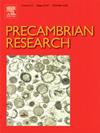从下成因和超成因改变的带状铁地层中重建原始海洋化学的潜力:以西澳大利亚韦尔德山脉为例
IF 3.2
2区 地球科学
Q2 GEOSCIENCES, MULTIDISCIPLINARY
引用次数: 0
摘要
原始带状铁地层(BIF)是重建其沉淀的古海水元素和同位素特征的公认古环境代用指标。在整个地球历史中,BIF 中页岩归一化稀土元素模式的变化微乎其微,包括低 La/Yb 比值、正 La、Eu、Gd 和 Y 异常等特征,以及接近于超软玉的 Y/Ho 比值,这些都支持古海水特征的保存。尽管如此,将古环境重建局限于原始的 BIF 会造成严重的取样偏差,限制对海洋时间演化的了解。然而,改变过的 BIF 样本由于其主要特征有可能受到干扰,因此在古环境重建方面存在问题。原始和蚀变 BIF 中的三种主要矿物组分包括碳酸盐(如菱铁矿和角闪石)、铁氧化物(如磁铁矿、赤铁矿和高铁铁矿)和硅酸盐(如石英和铁硅酸盐)。本研究调查了来自约2.7 Ga Weld Range B.C.的样品。2.7 Ga Weld Range BIF的样品。下绿泥石面BIF的变化程度从最轻微的改变到逐渐的低成因和/或超成因改变。对这些岩石的全岩分析表明,尽管发生了显著的蚀变,但仍保留了类似海水的特征,如 La、Eu 和 Y 阳性异常。此外,还对最少蚀变和蚀变的 BIF 样品进行了连续萃取技术,以分别分析碳酸盐、氧化铁和硅酸盐矿物组分。在最少蚀变和次生蚀变样品中,尽管次生蚀变样品中有大量次生碳酸盐和氧化铁矿物沉淀,但所有馏分都保留了类海水化学的证据。在次生碳酸盐和氧化铁馏分中保留的类海水特征是海水-岩浆流体混合物沉淀次生置换矿物的结果。因此,我们认为硅酸盐馏分最能体现沉淀 Weld Range BIF 的原生海水特征,而石英/白垩岩则反映了不受低级变质作用和次生蚀变影响的无定形二氧化硅特征。在广泛蚀变的韦尔德山脉 BIF 中保留了原生矿物相(即硅酸盐)和海水特征,这表明应更广泛地研究蚀变的 BIF,以提高全球古环境重建的广度和代表性。本文章由计算机程序翻译,如有差异,请以英文原文为准。
The potential for reconstructing primary ocean chemistry from hypogene and supergene altered banded iron formations: An example from Weld Range, Western Australia
Pristine banded iron formations (BIF) are established paleo-environmental proxies for reconstructing the elemental and isotopic signatures of the ancient seawater that they precipitated from. Negligible changes in shale-normalised rare earth element patterns in BIF throughout Earth’s history, including features such as low La/Yb ratios, and positive La, Eu, Gd, and Y anomalies, and near- to super-chondritic Y/Ho ratios support the preservation of ancient seawater signatures. Nevertheless, limiting paleo-environmental reconstructions to pristine BIF imparts a significant sampling bias and restricts understanding of the temporal evolution of the oceans. However, altered BIF samples are problematic for paleo-environmental reconstructions due to the risk of disturbance of their primary signatures. Instead, mineral-/fraction-specific analysis potentially provides robust paleo-environmental reconstructions where primary mineral phases are preserved, with the three main mineral fractions in pristine and altered BIF including carbonates (e.g., siderite and ankerite), Fe oxides (e.g., magnetite, hematite, and goethite), and silicates (e.g., quartz and Fe-silicates). This study investigates samples from the ca. 2.7 Ga Weld Range BIF, located in the Youanmi Terrane, Yilgarn Craton, Western Australia. The lower-greenschist facies BIF varies from least-altered to progressively hypogene- and/or supergene-altered. Whole-rock analysis of these rocks revealed the preservation of seawater-like signatures despite significant alteration, such as positive La, Eu and Y anomalies. Additionally, sequential extraction techniques were performed on the least-altered and altered BIF samples to separately analyse the carbonate, Fe oxide, and silicate mineral fractions. In both the least- and hypogene-altered samples all fractions preserved evidence for seawater-like chemistry despite extensive precipitation of secondary hypogene carbonate and Fe oxide minerals in the latter. The seawater-like characteristics preserved in the hypogene carbonate and Fe oxide-fractions are the result of the seawater-magmatic fluid mixture that precipitated hypogene replacement minerals. Therefore, we interpret the silicate-fraction to be the most indicative of the primary seawater that precipitated the Weld Range BIF, where the quartz/chert reflects amorphous silica signatures that are unaffected by low-grade metamorphism and hypogene alteration. The preservation of primary mineral phases (i.e., silicates) and characteristic seawater signatures in the extensively altered Weld Range BIF, suggests that altered BIF should be more widely investigated to improve the breadth and representativeness of global paleo-environmental reconstructions.
求助全文
通过发布文献求助,成功后即可免费获取论文全文。
去求助
来源期刊

Precambrian Research
地学-地球科学综合
CiteScore
7.20
自引率
28.90%
发文量
325
审稿时长
12 months
期刊介绍:
Precambrian Research publishes studies on all aspects of the early stages of the composition, structure and evolution of the Earth and its planetary neighbours. With a focus on process-oriented and comparative studies, it covers, but is not restricted to, subjects such as:
(1) Chemical, biological, biochemical and cosmochemical evolution; the origin of life; the evolution of the oceans and atmosphere; the early fossil record; palaeobiology;
(2) Geochronology and isotope and elemental geochemistry;
(3) Precambrian mineral deposits;
(4) Geophysical aspects of the early Earth and Precambrian terrains;
(5) Nature, formation and evolution of the Precambrian lithosphere and mantle including magmatic, depositional, metamorphic and tectonic processes.
In addition, the editors particularly welcome integrated process-oriented studies that involve a combination of the above fields and comparative studies that demonstrate the effect of Precambrian evolution on Phanerozoic earth system processes.
Regional and localised studies of Precambrian phenomena are considered appropriate only when the detail and quality allow illustration of a wider process, or when significant gaps in basic knowledge of a particular area can be filled.
 求助内容:
求助内容: 应助结果提醒方式:
应助结果提醒方式:


